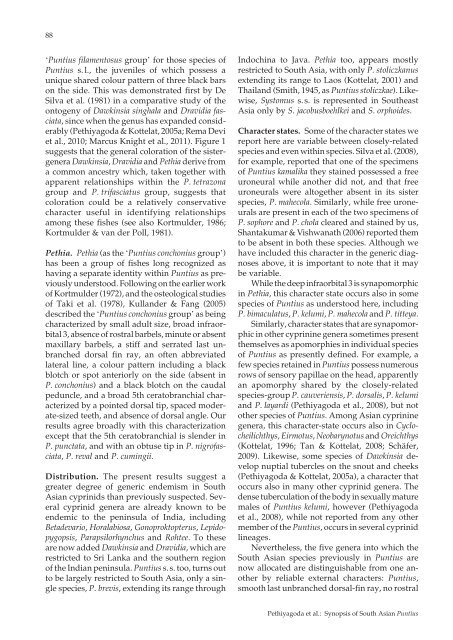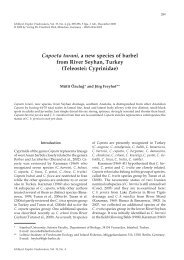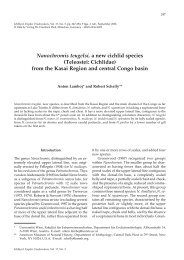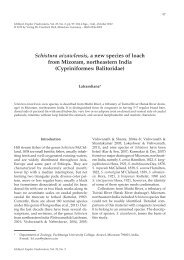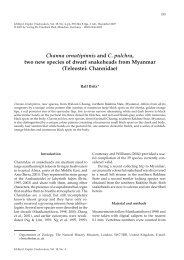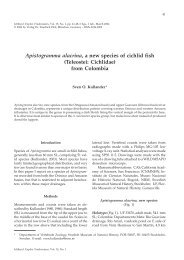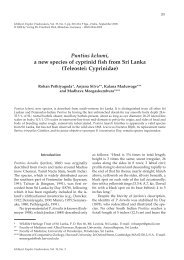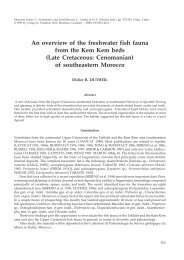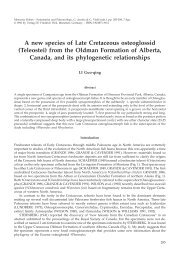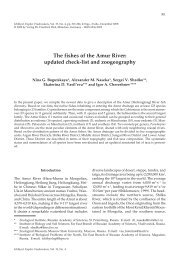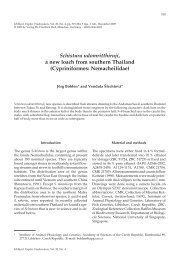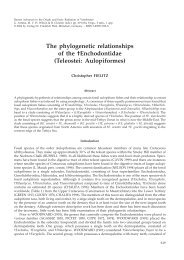A synopsis of the South Asian fishes referred to Puntius - Verlag Dr ...
A synopsis of the South Asian fishes referred to Puntius - Verlag Dr ...
A synopsis of the South Asian fishes referred to Puntius - Verlag Dr ...
You also want an ePaper? Increase the reach of your titles
YUMPU automatically turns print PDFs into web optimized ePapers that Google loves.
88<br />
‘<strong>Puntius</strong> filamen<strong>to</strong>sus group’ for those species <strong>of</strong><br />
<strong>Puntius</strong> s. l., <strong>the</strong> juveniles <strong>of</strong> which possess a<br />
unique shared colour pattern <strong>of</strong> three black bars<br />
on <strong>the</strong> side. This was demonstrated first by De<br />
Silva et al. (1981) in a comparative study <strong>of</strong> <strong>the</strong><br />
on<strong>to</strong>geny <strong>of</strong> Dawkinsia singhala and <strong>Dr</strong>avidia fasciata,<br />
since when <strong>the</strong> genus has expanded considerably<br />
(Pethiyagoda & Kottelat, 2005a; Rema Devi<br />
et al., 2010; Marcus Knight et al., 2011). Figure 1<br />
suggests that <strong>the</strong> general coloration <strong>of</strong> <strong>the</strong> sistergenera<br />
Dawkinsia, <strong>Dr</strong>avidia and Pethia derive from<br />
a common ancestry which, taken <strong>to</strong>ge<strong>the</strong>r with<br />
apparent relationships within <strong>the</strong> P. tetrazona<br />
group and P. trifasciatus group, suggests that<br />
coloration could be a relatively conservative<br />
character useful in identifying relationships<br />
among <strong>the</strong>se <strong>fishes</strong> (see also Kortmulder, 1986;<br />
Kortmulder & van der Poll, 1981).<br />
Pethia. Pethia (as <strong>the</strong> ‘<strong>Puntius</strong> conchonius group’)<br />
has been a group <strong>of</strong> <strong>fishes</strong> long recognized as<br />
having a separate identity within <strong>Puntius</strong> as previously<br />
unders<strong>to</strong>od. Following on <strong>the</strong> earlier work<br />
<strong>of</strong> Kortmulder (1972), and <strong>the</strong> osteological studies<br />
<strong>of</strong> Taki et al. (1978), Kullander & Fang (2005)<br />
described <strong>the</strong> ‘<strong>Puntius</strong> conchonius group’ as being<br />
characterized by small adult size, broad infraorbital<br />
3, absence <strong>of</strong> rostral barbels, minute or absent<br />
maxillary barbels, a stiff and serrated last unbranched<br />
dorsal fin ray, an <strong>of</strong>ten abbreviated<br />
lateral line, a colour pattern including a black<br />
blotch or spot anteriorly on <strong>the</strong> side (absent in<br />
P. conchonius) and a black blotch on <strong>the</strong> caudal<br />
peduncle, and a broad 5th cera<strong>to</strong>branchial characterized<br />
by a pointed dorsal tip, spaced moderate-sized<br />
teeth, and absence <strong>of</strong> dorsal angle. Our<br />
results agree broadly with this characterization<br />
except that <strong>the</strong> 5th cera<strong>to</strong>branchial is slender in<br />
P. punctata, and with an obtuse tip in P. nigr<strong>of</strong>asciata,<br />
P. reval and P. cumingii.<br />
Distribution. The present results suggest a<br />
greater degree <strong>of</strong> generic endemism in <strong>South</strong><br />
<strong>Asian</strong> cyprinids than previously suspected. Several<br />
cyprinid genera are already known <strong>to</strong> be<br />
endemic <strong>to</strong> <strong>the</strong> peninsula <strong>of</strong> India, including<br />
Betadevario, Horalabiosa, Gonoprok<strong>to</strong>pterus, Lepidopygopsis,<br />
Parapsilorhynchus and Rohtee. To <strong>the</strong>se<br />
are now added Dawkinsia and <strong>Dr</strong>avidia, which are<br />
restricted <strong>to</strong> Sri Lanka and <strong>the</strong> sou<strong>the</strong>rn region<br />
<strong>of</strong> <strong>the</strong> Indian peninsula. <strong>Puntius</strong> s. s. <strong>to</strong>o, turns out<br />
<strong>to</strong> be largely restricted <strong>to</strong> <strong>South</strong> Asia, only a single<br />
species, P. brevis, extending its range through<br />
Indochina <strong>to</strong> Java. Pethia <strong>to</strong>o, appears mostly<br />
restricted <strong>to</strong> <strong>South</strong> Asia, with only P. s<strong>to</strong>liczkanus<br />
extending its range <strong>to</strong> Laos (Kottelat, 2001) and<br />
Thailand (Smith, 1945, as <strong>Puntius</strong> s<strong>to</strong>liczkae). Likewise,<br />
Sys<strong>to</strong>mus s. s. is represented in Sou<strong>the</strong>ast<br />
Asia only by S. jacobusboehlkei and S. orphoides.<br />
Character states. Some <strong>of</strong> <strong>the</strong> character states we<br />
report here are variable between closely-related<br />
species and even within species. Silva et al. (2008),<br />
for example, reported that one <strong>of</strong> <strong>the</strong> specimens<br />
<strong>of</strong> <strong>Puntius</strong> kamalika <strong>the</strong>y stained possessed a free<br />
uroneural while ano<strong>the</strong>r did not, and that free<br />
uroneurals were al<strong>to</strong>ge<strong>the</strong>r absent in its sister<br />
species, P. mahecola. Similarly, while free uroneurals<br />
are present in each <strong>of</strong> <strong>the</strong> two specimens <strong>of</strong><br />
P. sophore and P. chola cleared and stained by us,<br />
Shantakumar & Vishwanath (2006) reported <strong>the</strong>m<br />
<strong>to</strong> be absent in both <strong>the</strong>se species. Although we<br />
have included this character in <strong>the</strong> generic diagnoses<br />
above, it is important <strong>to</strong> note that it may<br />
be variable.<br />
While <strong>the</strong> deep infraorbital 3 is synapomorphic<br />
in Pethia, this character state occurs also in some<br />
species <strong>of</strong> <strong>Puntius</strong> as unders<strong>to</strong>od here, including<br />
P. bimaculatus, P. kelumi, P. mahecola and P. titteya.<br />
Similarly, character states that are synapomorphic<br />
in o<strong>the</strong>r cyprinine genera sometimes present<br />
<strong>the</strong>mselves as apomorphies in individual species<br />
<strong>of</strong> <strong>Puntius</strong> as presently defined. For example, a<br />
few species retained in <strong>Puntius</strong> possess numerous<br />
rows <strong>of</strong> sensory papillae on <strong>the</strong> head, apparently<br />
an apomorphy shared by <strong>the</strong> closely-related<br />
species-group P. cauveriensis, P. dorsalis, P. kelumi<br />
and P. layardi (Pethiyagoda et al., 2008), but not<br />
o<strong>the</strong>r species <strong>of</strong> <strong>Puntius</strong>. Among <strong>Asian</strong> cyprinine<br />
genera, this character-state occurs also in Cyclocheilichthys,<br />
Eirmotus, Neobarynotus and Oreichthys<br />
(Kottelat, 1996; Tan & Kottelat, 2008; Schäfer,<br />
2009). Likewise, some species <strong>of</strong> Dawkinsia develop<br />
nuptial tubercles on <strong>the</strong> snout and cheeks<br />
(Pethiyagoda & Kottelat, 2005a), a character that<br />
occurs also in many o<strong>the</strong>r cyprinid genera. The<br />
dense tuberculation <strong>of</strong> <strong>the</strong> body in sexually mature<br />
males <strong>of</strong> <strong>Puntius</strong> kelumi, however (Pethiyagoda<br />
et al., 2008), while not reported from any o<strong>the</strong>r<br />
member <strong>of</strong> <strong>the</strong> <strong>Puntius</strong>, occurs in several cyprinid<br />
lineages.<br />
Never<strong>the</strong>less, <strong>the</strong> five genera in<strong>to</strong> which <strong>the</strong><br />
<strong>South</strong> <strong>Asian</strong> species previously in <strong>Puntius</strong> are<br />
now allocated are distinguishable from one ano<strong>the</strong>r<br />
by reliable external characters: <strong>Puntius</strong>,<br />
smooth last unbranched dorsal-fin ray, no rostral<br />
Pethiyagoda et al.: Synopsis <strong>of</strong> <strong>South</strong> <strong>Asian</strong> <strong>Puntius</strong>


